Micro Learning Futures
Quick thoughts on the future of learning
Last updated 3 years ago
Ideas are listed in generally-reverse-chronological order, meaning that as I add new ideas to this page they will show up at the top. However if you want to start at #1, press the button below.
#31: Enough recipes and you have a cook
As I continue to experiment with the creativity recipes I described
in #5{#link-to–5–10}{#link-to–5–8}
I continue to find new recipes through combinations of different
constraints and themes that I likeSimilarly, my friends and I like to come up with
different variations and games using bananagrams tiles. Some of our
favourite variations come from trying out really silly constraints (like
made-up-word bananagrams, where you’re not allowed to use any real
word), and then combining them together to create something much more
interesting (e.g. made-up-word relations
bananagrams)
In made-up-word relations bananagrams, each two
made-up words that intersect must be related to each other in some way
and you have to be able to describe why. In essence, this turns the game
into a language/world-building exercise where by the end of the game
nearly half the words you’re speaking to each other sound like gibberish
to the outside listener.
. It’s very similar to cooking in a way—one might start
out following recipes by the book but over time (if you don’t solely
rely on the recipe like a crutch) you’ll start to get a sense, beyond
the recipes, for how different flavours and ingredients interact.
#30: Child’s perspective
Children, of course, are the most intuitively knowledgable when it comes to designing spaces for children. Their opinion should be valued. If you listen, you’ll likely discover something unexpected—like this one child who, while giving a child-guided tour chose the gym as one of his favourite places in the school, then when asked why he pointed up at the ceiling described how he liked the shadows cast by the wooden beams above.
#29: Third teacher
Just stumbled upon this idea of the “third teacher.” In designing spaces of learning, the architecture ought to embody the teaching in the way it’s designed:
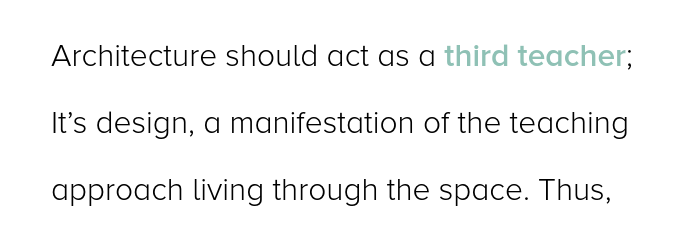
I can also imagine this applying (perhaps to a lesser extent?) in digital spaces…
#28: Tri-amphitheatre
Inspired by the amphitheatre room-layout depicted in #24{#link-to–24–29}{#link-to–24–22}, I thought: what if you arranged multiple semi-circular amphitheatre spaces around in a circle?
If you only have one amphitheatre then it can either be used as workshop / presentation space, or be an open space for people to sit, work, and hang out—it can’t be both at once. If you have multiple amphitheatre’s though you can have different events/non-events happening in each.
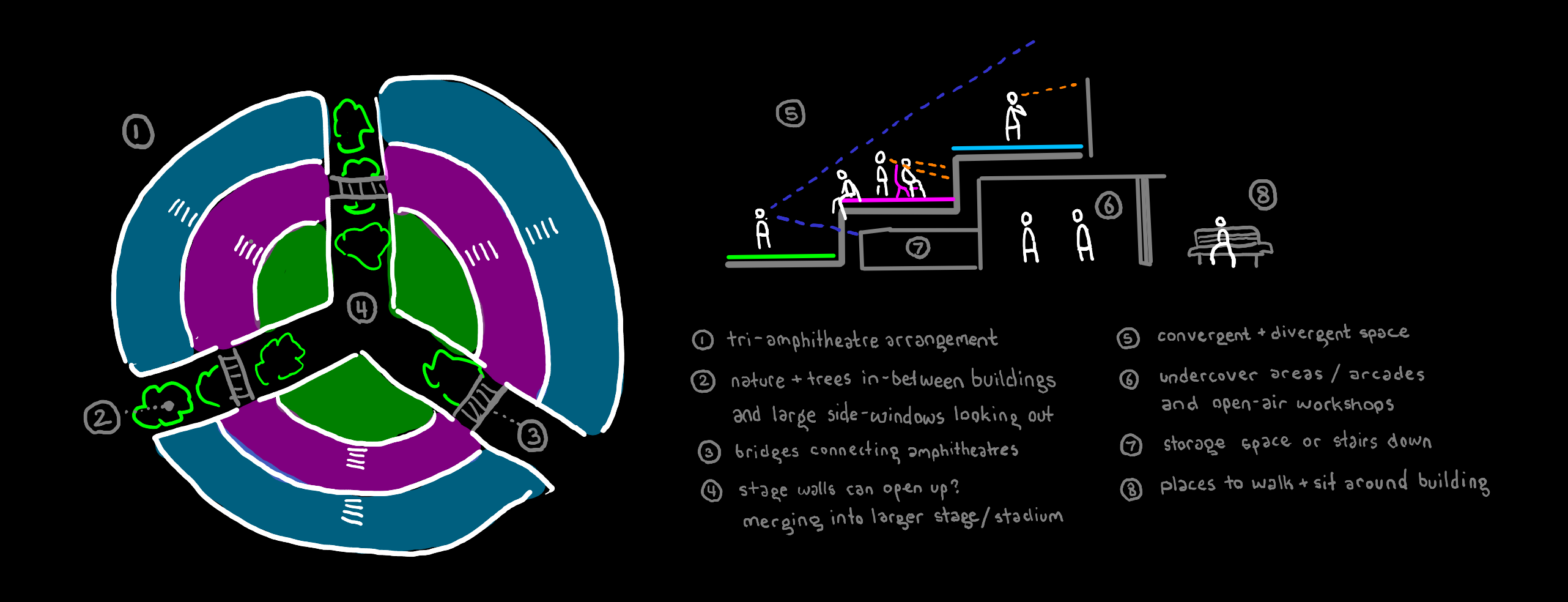
- tri-amphitheatre arrangement
- trees + nature in-between buildings, and large side-windows looking out
- bridges connecting amphitheatres
- stage walls can open up? merging into larger stage / stadium for bigger events, performances, or speakers
- supporting convergent + divergent social spaces
- undercover areas / arcades, and open-air workshops
- storage space or stairs down (basement?)
- places to walk + sit around building
This is an interesting example of bottom-up design, where you don’t imagine a structure first but start with the experiences that you want to create. The evolution of this concept can be traced (primarily) through: #3{#link-to–3–27}{#link-to–3–26}{#link-to–3–20}{#link-to–3–19}{#link-to–3–7}{#link-to–3–4}, #18{#link-to–18–23}, #21{#link-to–21–25}{#link-to–21–21}, #24, and #25. When I first wrote idea #3 I was certainly not yet imagining such a space as I have layed out here.
#27: Small room, long table
I imagine for something like a “writer’s room”, while you can put prompts, resources, and other information up on the walls—the actual process of writing doesn’t change much. In fact much of my explorations so far (see: #3, #21, #22) have been more focused on reimagining a learning environment for mathematics, which lends itself particularly well to putting up difficult challenges to solve that activates people’s problem-solving. However, for other activities, like writing or sewing or woodworking,
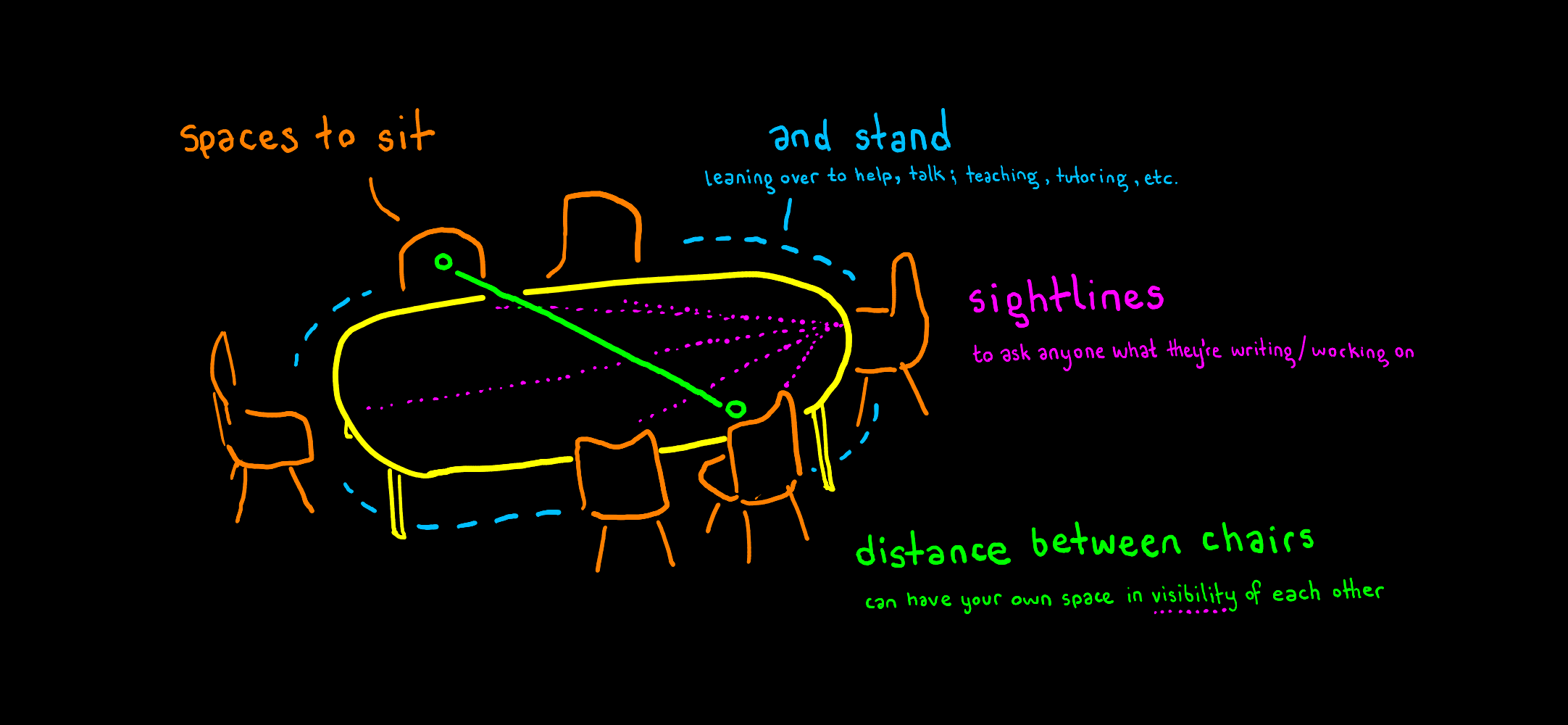
#26: School doodle
Just doodling some floor plan / layout for an imaginary school
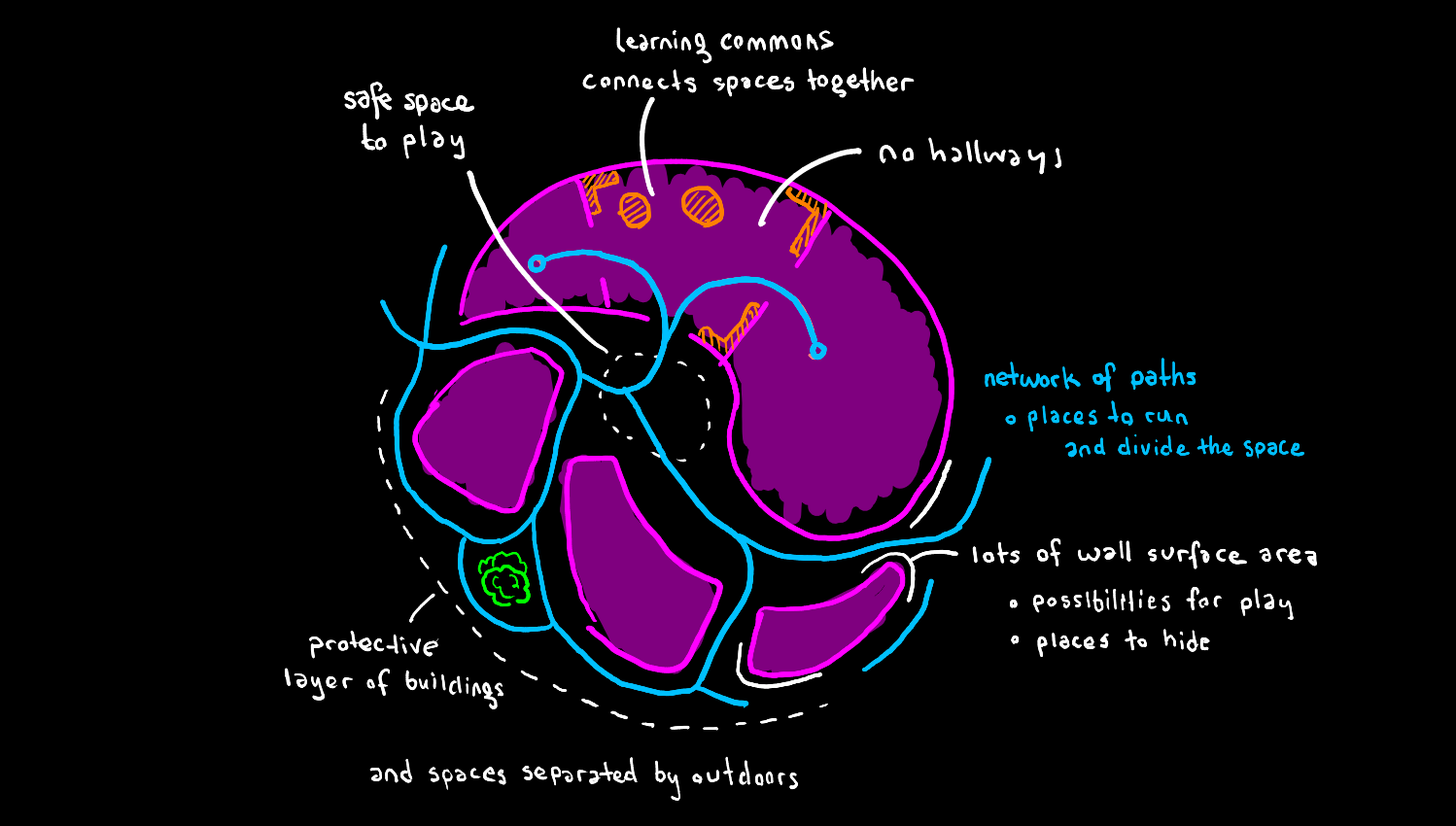
Interesting what kinds of patterns you can reason about and fit together in a single sketch:
- outer buildings providing a protective layer to create safe play space in the inner courtyard
- a learning commons / library as a place of passage between
spacesnot sure if this is a great idea, because then the
library will get the noise from all the neighbouring classrooms
and all the people passing through
- no hallways (see #18)
- lots of wall surface areas creates posibilities for play, as well as places to hide
- network of paths helps facilitate games running around and to divide the space for games like “capture the flag”
#25: Amphitheatre of Learning
Thinking about verticality and elevated spaces (#24) I was just reminded of the WeWork near the top of the Salesforce tower in SF.
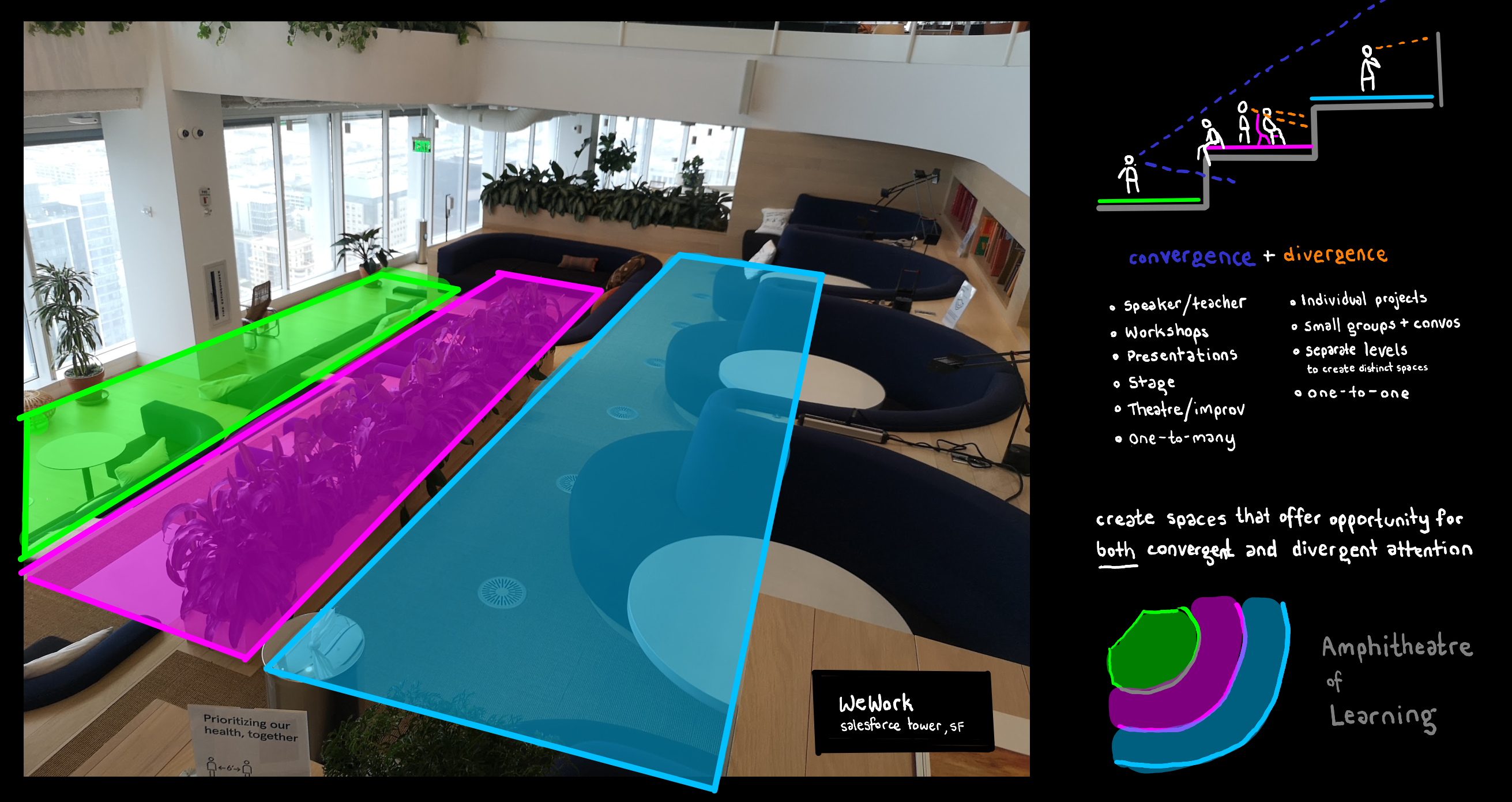
#24: Verticality
Incorporating multiple levels of verticality can help distinguish different parts of a space from one another. Similarly to bouldering gyms where you step onto the mat to approach the wall, maybe it makes sense to separate the space with a slightly raised platform / elevated area near the wall…
On top of the pull/push this creates to guide how you interact with the space, a ledge or raised platform can also create spaces to sit (maybe the elevated area should be padded?), as well as a place for storage or floor-level bookshelves:
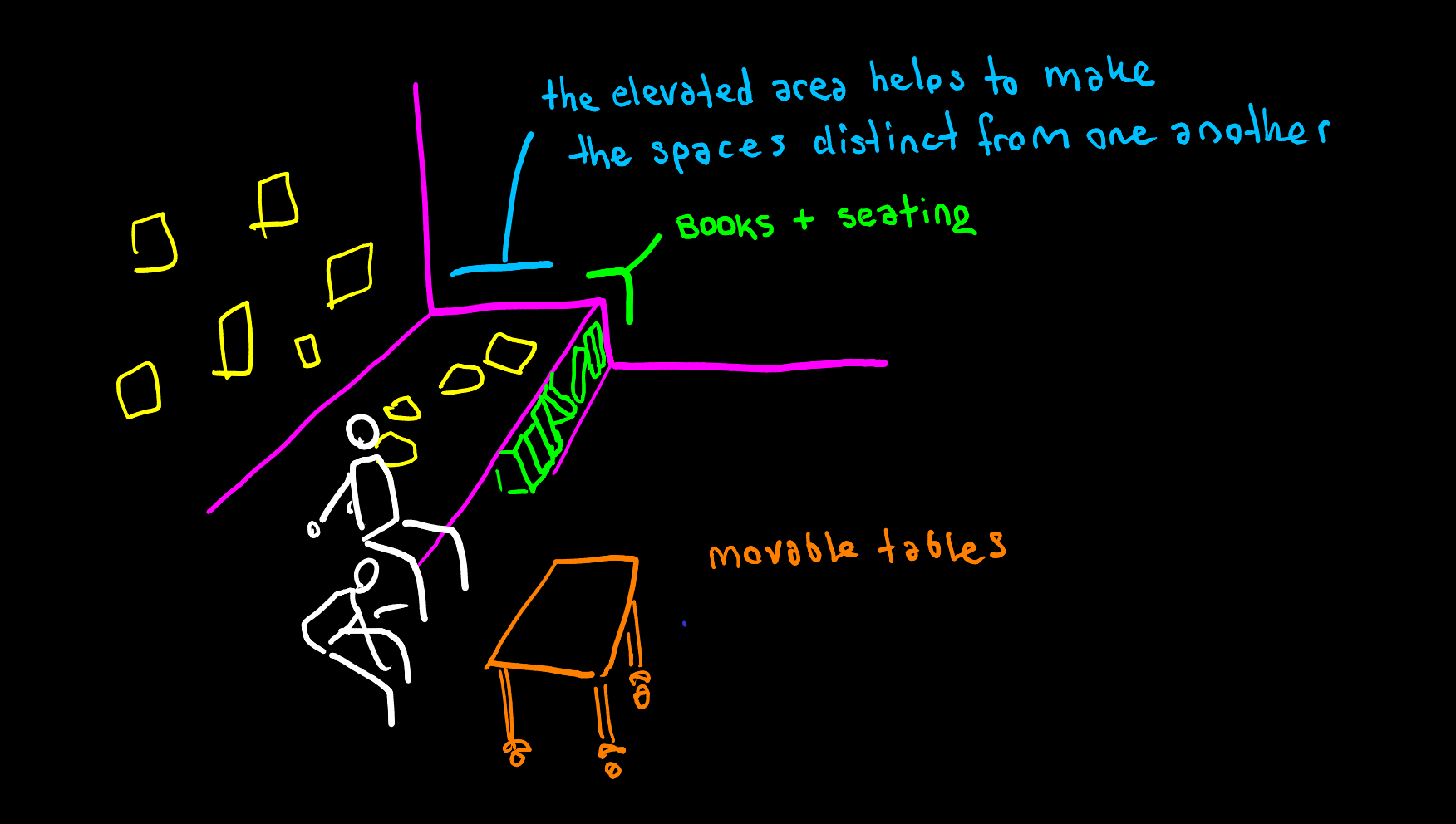
#23: Biology metaphor
Students often describe classrooms as being rather like a cell…
Just imagine if that was a metaphor to biological cells rather than prison cells! then maybe we can tweak a few of the educhemical reactions along the way…
#22: Intestine-style design
I was just thinking that if you have a space too open, it starts to feel awkward like you have many eyes watching, but if you make a space too closed, it feels like you’re alone.
As well, if the walls are used to put up prompts and challenges (see #21, #3) then in some ways you want to maximize the surface area of the walls right?
Both these principles lead me to imagine “squishing” the space so that you have social spaces along the middle in-between the walls on either side, as well as additional surface area:
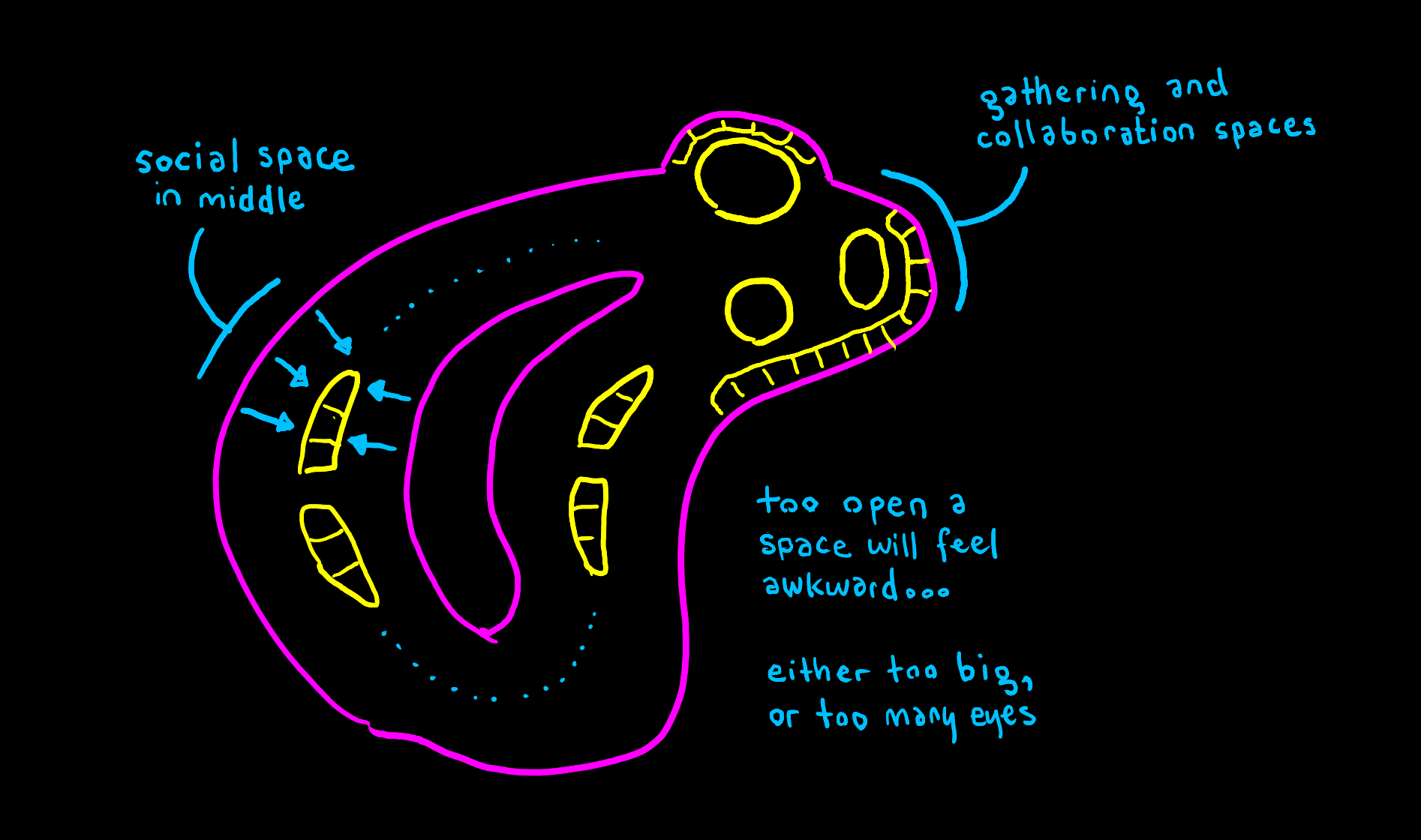
I think there needs different typologies of spaces so I included some tables in the corner (if you can really have a corner on a curved wall…) to allow for groups to gather around a table together.
Here’s another intestine-like space:
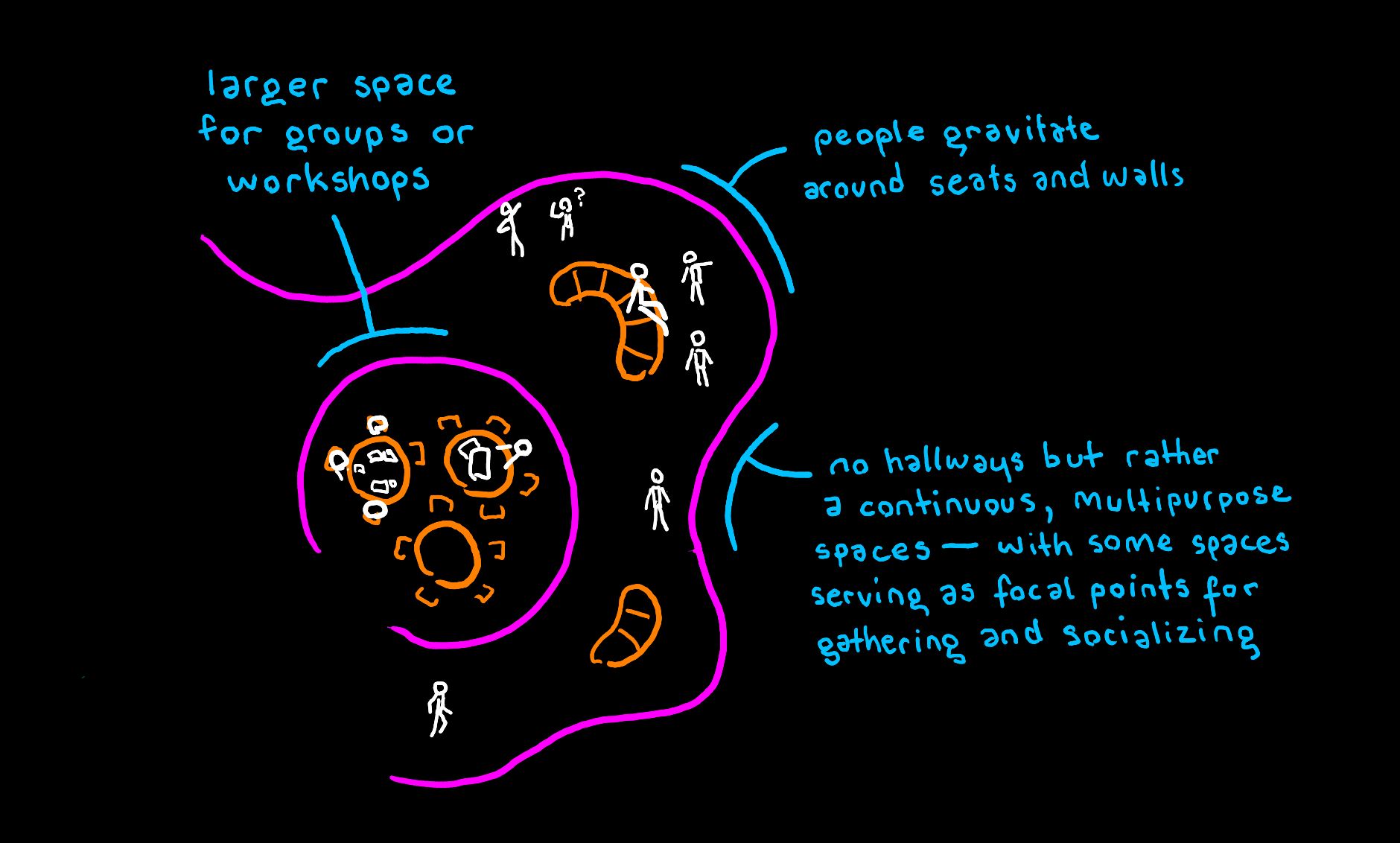
#21: Theatre of the mind
Furthering my explorations in #3, and the metaphor
of CLASSROOM as BOULDERING GYMwhich I also explored through a short design-fiction
titled, Bouldering in the
Classroom{#link-to–stories-bouldering-in-the-classroom–2}
. What would a classroom designed as a divergent space
look like?
Imagining challenges posted on the walls, and seats in the middle for both working on problems and socializing:
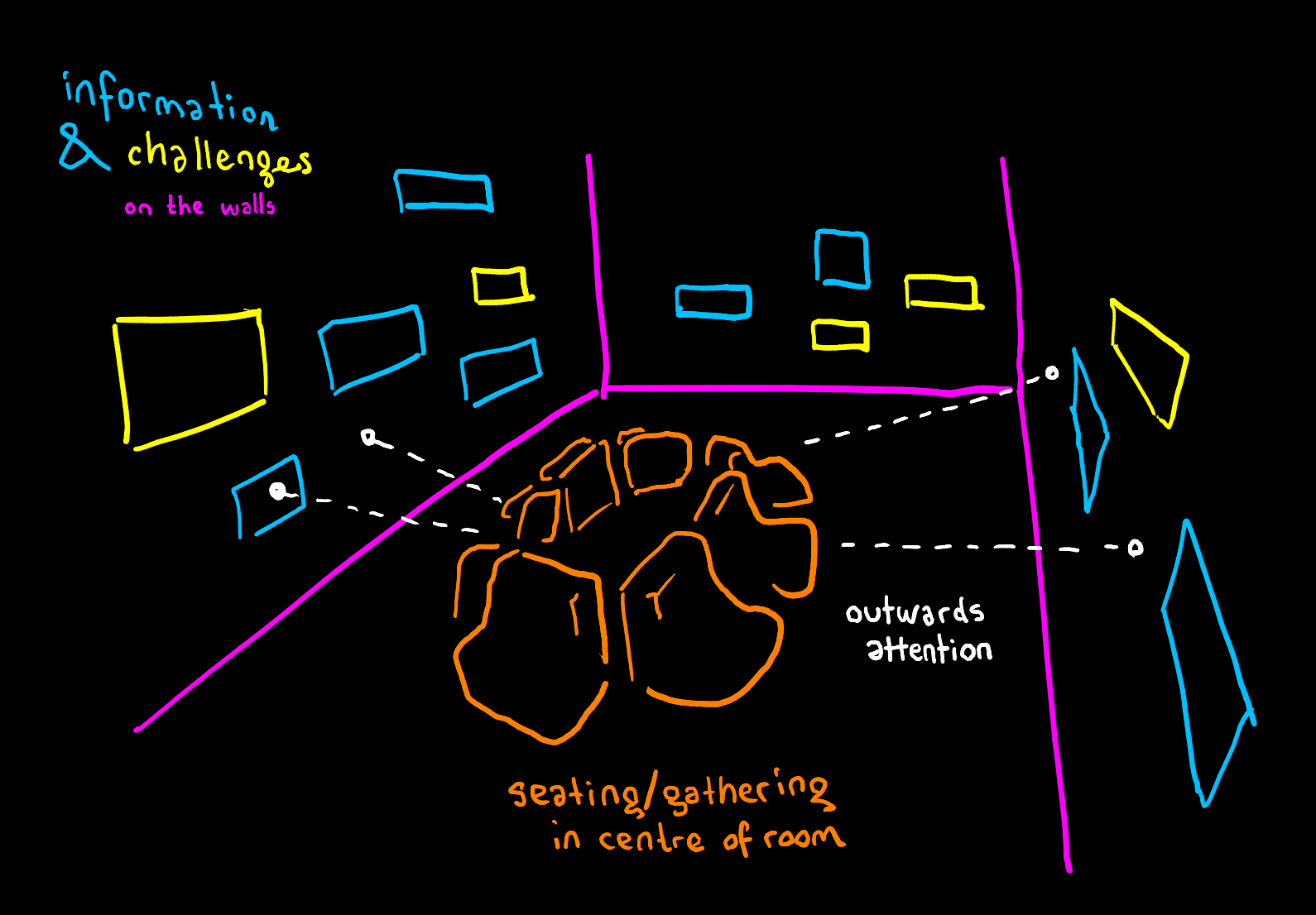
#20: Conductive substrate
What makes a strong community? From one perspective it’s easy to think of the strength of a community being correlated with the density of interconnections, or who knows who within the community:
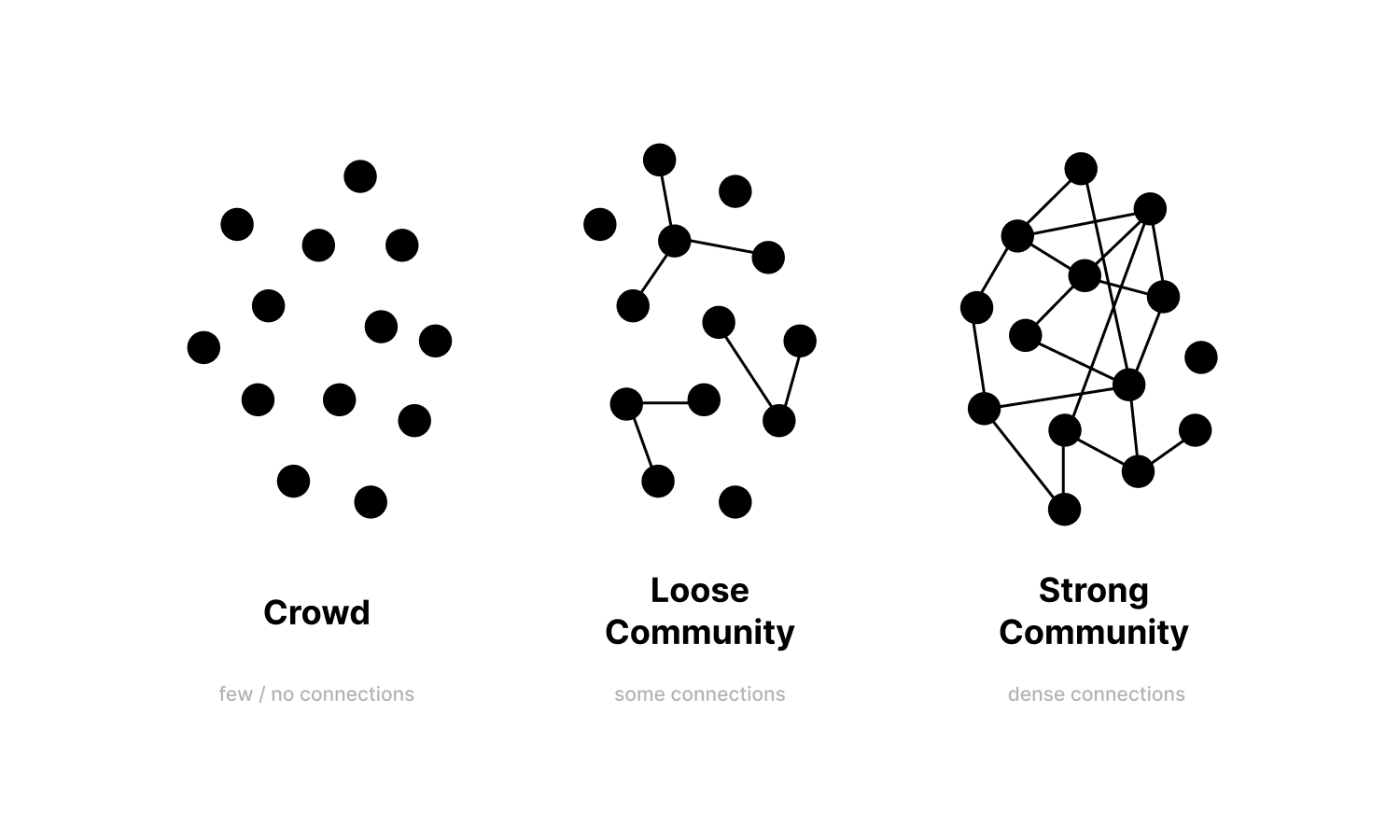
However there is another more important axis to pay attention to: the fragility or resilience of a community. Do people keep a rigid set of connections, or do people within the community keep bumping into each other, forming new connections and relationships? The context which creates the latter is what I call a “conductive substrate” of a community
Whether by social norms, facilitating interaction, random pairing, or creating environments for bumping into new people— a conductive substrate is what keeps a community alive, what makes that community more resilient and antifragile against change.
#19: Group vs. Community
I’d like to make a distinction between a “group” and a “community”: a group tends to have a hard boundary, you can identify who is and is not part of a group; however a “community” has soft edges, people can be active in the centre of a community, or they can be on the fringes less engaged but still identifying with the goal, mission, or community as a whole.
And by extension a club is a group with a process of becoming a member, whether by monetary contribution or simply through application. Normally membership in a group is more arbitrary, simply a collection of friends or people you’ve invited to take part.
Because community tends to be a larger and blurrier concept, a community tends to contain within it many different groups or clubs. And perhaps to a small (or large?) extent, the multitude of groups within a community strengthen the overall feeling of community, just as the roots of a plant keep it steady and upright.
#18: Eliminate dead space
The notion of rooms and hallways creates unnecessary divide and separation where hallways are seen as dead space, a place of movement — just like a road — whereas perhaps it can be something more, a more mixed and inviting space of mingling and collaboration alongside more permeable rooms and spaces:
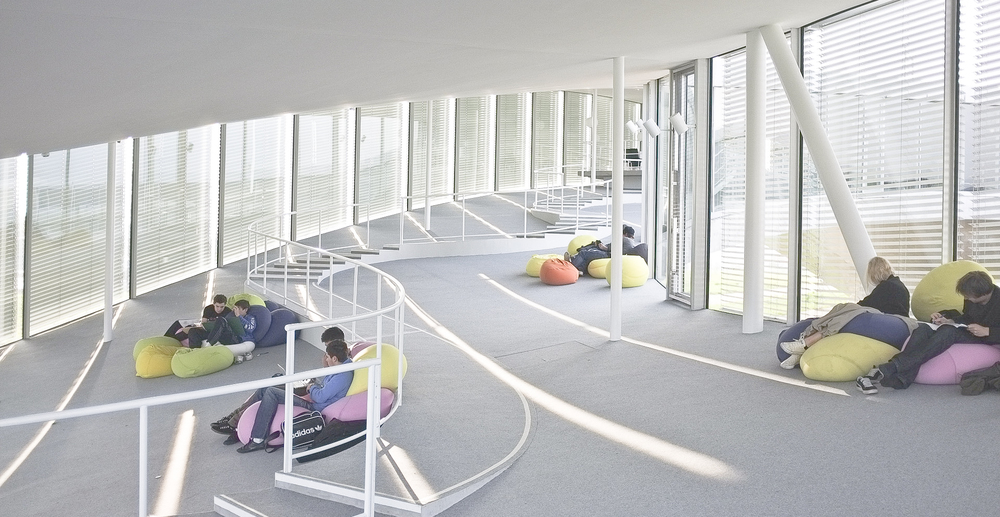
I am reminded by the design of EPFL’s Rolex Learning Center, which I have never myself visited but only read about and experienced through images and video:
Inside, the hills, valleys and plateaus formed by the undulation often make the edges of the building invisible, though there are no visual barriers between one area and the next. Instead of steps and staircases, there are gentle slopes and terraces. Clearly, but without dividing walls, one area of activity gives way to another.
Source
#17: Publishing house
Jumping off the idea of a kickstarter for ideas (#16), I was recently exploring what a digital campus might look like and came to the conclusion (among others) that it is important to provide meaningful opportunities, especially in the case of a digital campus where you lack the typical opportunities and space afforded to you by a campus.
More specifically, I started to imagine
university as publishing house:
In a sense, I imagine behind-the-scenes of a digital campus to be much like a publishing house or press— though not constrained solely to publishing books / magazines. Any emergent artifacts of learning can potentially be turned into more polished, tangible form.
Particularly if people are gathering together and participating in challenges mostly autonomously on their own accord, it makes sense to me that the services provided by the campus / university / whatchamacallit should serve to augment the existing creativity and experimentation coming out of the community: serving roles of both guides and a bridge between students and the outside world through providing opportunities for meeting people, publishing their work, participating in the campus magazine, etc.
Additionally it is important on a digital campus, for any publications to have much wider reach and recognition than just solely within the campus itself. A typical college radio station or magazine doesn’t need a far-reaching readership, but for a digital campus, an audience and respected public image are key to making that opportunity meaningful.
#16: Kickstarter for ideas
Bouncing off from #7 (flopped classroom) where I describe an idea for a “challenge platform” where people can post and participate in creative challenges. Another way of framing this concept is as a “kickstarter for ideas” where, instead of monetary contribution like you have on kickstarter, you are contributing your time, creativity, and ideas to each challenge you participate in. And if enough people participate, or you gather together a sufficient number of submissions, then you may decide collectively to transform your work into some kind of artifact: a set of short stories could become a small book or anthology for example!
By participating in many challenges you may occasionally be able to collectively publish your work here and there. While unlikely to bring participants substantial windfall,
#15: World-class teachers
I don’t believe the myth of “world-class teachers” put forward by MOOCs and online-learning industry. The fact that the internet gives us access to the “best” teachers, where “best” tends to be synonymous with most prestigious or famous. I would be surprised if anyone, when asked who has been their best teacher in their life would ever respond with an online expert lecturing them in quantum mechanics or some other gibbledegok. The idea of there being “world-class teachers” that everyone ought to learn from overlooks the real and more important role of a teacher as a supporter and guide of your learning.
Instead of aspiring to be taught by world-class teachers I think we ought to aspire to become world-class students.
#14: Future thinking
Teachers are typically constrained by the past, teaching history or well-defined knowledge and discoveries from textbooks. Without a teacher, or when you’re on a level playing-field with other peers / participants enables new kinds of classes and workshops that might not have previously been possible. In short: future thinking.
In a world where we have millions of minds worth of latent information and facts literally at our finger-tips, in a world ever-more at a crossroads of uncertainty, we need to be exploring and thinking about the future more than ever. Exploring and researching the future rather than the past holds little place in today’s educational system outside of the ivory tower of post-graduate studies and academic research labs.
I think that peer learning (#12{#link-to–12–11}), or teacher as peer (#13) both level the playing ground of experience, allowing you to explore future possibilities together
#13: Teacher as peer
In #12 I describe how peers can learn effectively from each other because experts have developed higher-level chunks of knowledge that impede their own introspection of which insights led to their own understanding. However there is a third option: teacher as peer.
Imagine if teachers were great guides but not knowledgeable at all about what they teach. Imagine if they are learning the topic alongside their students, researching and exploring any topics they don’t know and building their own understanding as they teach it. This often happens anyways, you only need to be a week ahead of your students sometimes to feign superiority. However, what would the classroom feel like if the students know that their teacher is at the same level as them, that they’re on a level playing field together?
#12: Peer learning
Often we learn best from peers as they often understand (from most recently experiencing it themselves) the difficulties or snags to understanding a concept. Teachers, even some of the best teachers, suffer from what I call “expert amnesia”. As you learn more and more you build up bigger and bigger chunks of knowledge inside your head, you begin to forget the exact series of understandings led to the smaller chunks in the first place! While this results in a better overall understanding, and a sense for the landscape of a discipline, it makes it difficult to retrospect on how best to learn a topic or what bits of information are most important to understanding. Thus the teacher must be masterful at observation, picking up on clues in the student’s understanding to be able to chart an adequate path forward through their own landscape of knowledge.
Since other students have not yet superceded their learning with larger chunks of understanding, they should be respected for being able to teach closer to their peer’s perspective.
#11: Silly walls
It occurs to me that we often construct walls in all the wrong places, and no boundary where we ought to have one.
In our computer interfaces for example we have unnecessary barriers
between applications (so-called walled gardens), and no
barriers between different workspaces — which just leads us to
juggle between different contexts and struggle to get stuff to do what
we wantLuckily nobody notices just how bad the whole situation
is because people are pretty resourceful at getting stuff done with
whichever tools they have at their disposal
.
Likewise we have a lot of silly walls in education: the arbitrary separation between age-groups, the barriers between transferring between schools, etc.
#10: Checklist education
I have a term I dub “checklist education” to refer to the current system of teaching strictly to a curriculum and rubric, that the teaching process boils down to checking boxes off the list of prescribed learning outcomes rather than sincerely guiding students through a learning process.
I am reminded somewhat of tourism, our industry of “exploring” the physical world. A strict curriculum is like a tightly-planned travel itinerary of guided tours, checking off your list of landmarks and monuments one-by-one without truly experiencing what it’s like to explore the city by foot. I for one, prefer the latter.
#9: Metaphors of learning
One of my creative recipes (see #5) is called
“Ouroborophorical”the name is derived from another exercise of chaining
statements which I call the “Ouroboros game”, except here I’ve shifted
the focus to chaining metaphors
— a short game where you chain together metaphors until
you come back to the original idea you started with. Here is the result
of a game I played starting and ending with the word “classroom”:
classroom as bouldering gym
bouldering gym as puzzle
puzzle as detective work
detective work as treasure hunt
treasure hunt as archaeology
archaeology as research
research as rabbit-hole
rabbit-hole as portal
portal as "jump"
jump as an insight
insight as a cabinet of curiosities
cabinet of curiosities as a museum
museum as a classroom
Upon completing the loop I was struck by how most of these metaphors
are interopable, classroom as detective work and
classroom as cabinet of curiosities both “work”, the
metaphors laid out are congruent and inter-supportive. Each can give a
different perspective on classrooms or the learning process. I
particularly enjoy the idea of a classroom as a
treasure hunt or archaeology, exploring the
idea of uncovering and piecing together ideas (similarly to a puzzle
right?).
Where I had expected this exercise to yield a set of completely disjointed metaphors, it turned out to result in a densely interconnected network of ideas…
#8: Jigsaw puzzle
What if when you bought a textbook, it was more like a jigsaw puzzle?
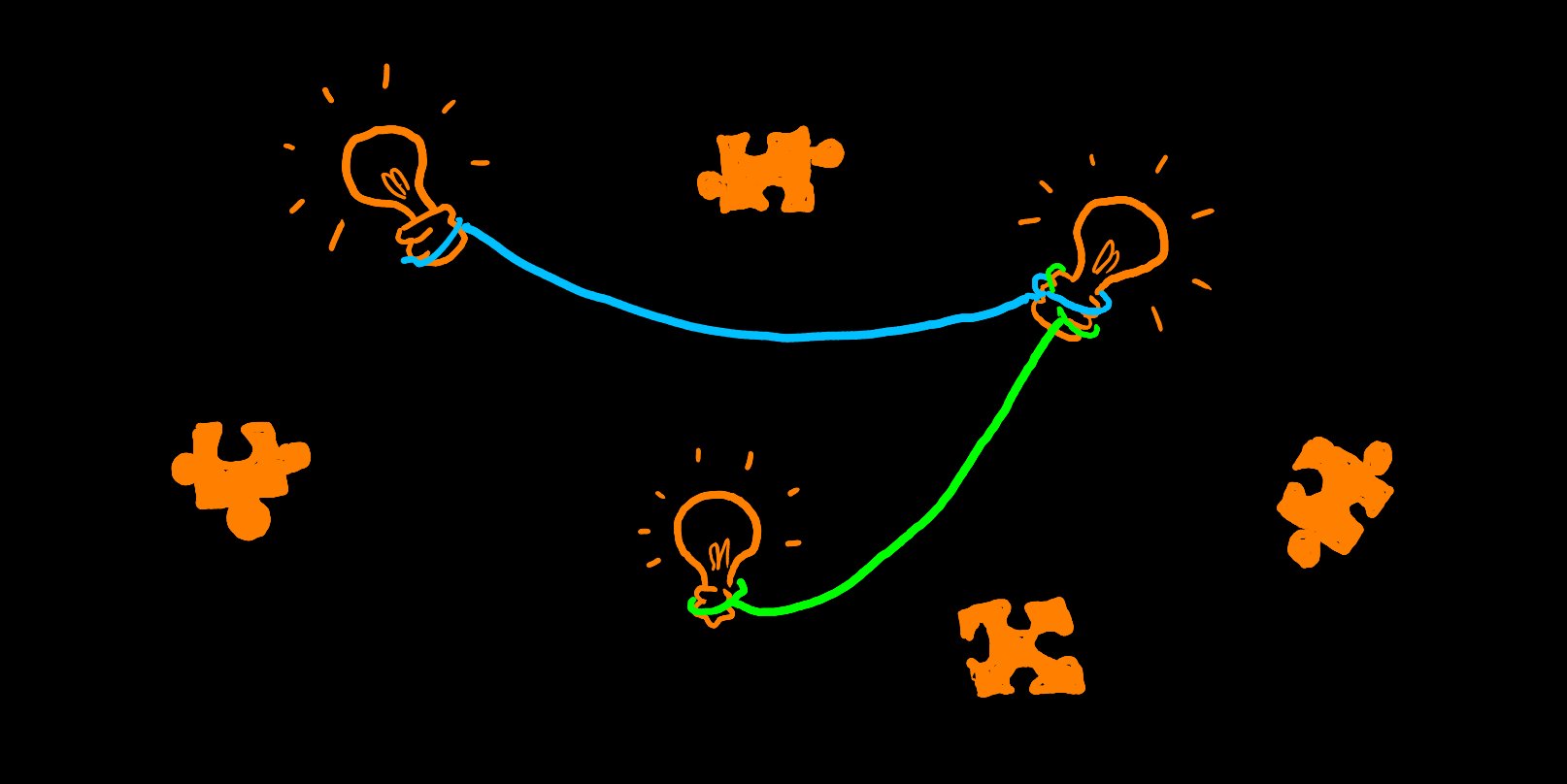
You open it up and out pours a thousand ideas and concepts, then it is your task to figure out which pieces connect and build up ideas until you see the bigger picture…
#7: Flopped classroom
In the spirit of #1{#link-to–1–6} and #5 I’ve had a vision for what I call a “challenge platform,” a place where people can share and participate in challenges together. Upon participating you can explore other’s creations and join a private chat with the other participants. However until now I’ve struggled in trying to adequately explain the essence this idea to people. Why is it important?
In schools and universities today, the general structure is that you sign up for a class upon which you and the other students (your group / cohort) come together and the teacher sets forward different assignments and challenges for you to complete, grades you on how well you accomplish them, and then those grades end up on your permanent record.
The model I envision flips this around entirely. First, students may puruse different challenges, prompts, or constraints and participate in the ones they’re most drawn to. Then they join the group of others that have participated in the challenge. Already having something in common (having been sufficiently interested in the challenge to participate) and being able to give each other feedback on their work it creates a perfect environment to meet new people aligned with your interests.
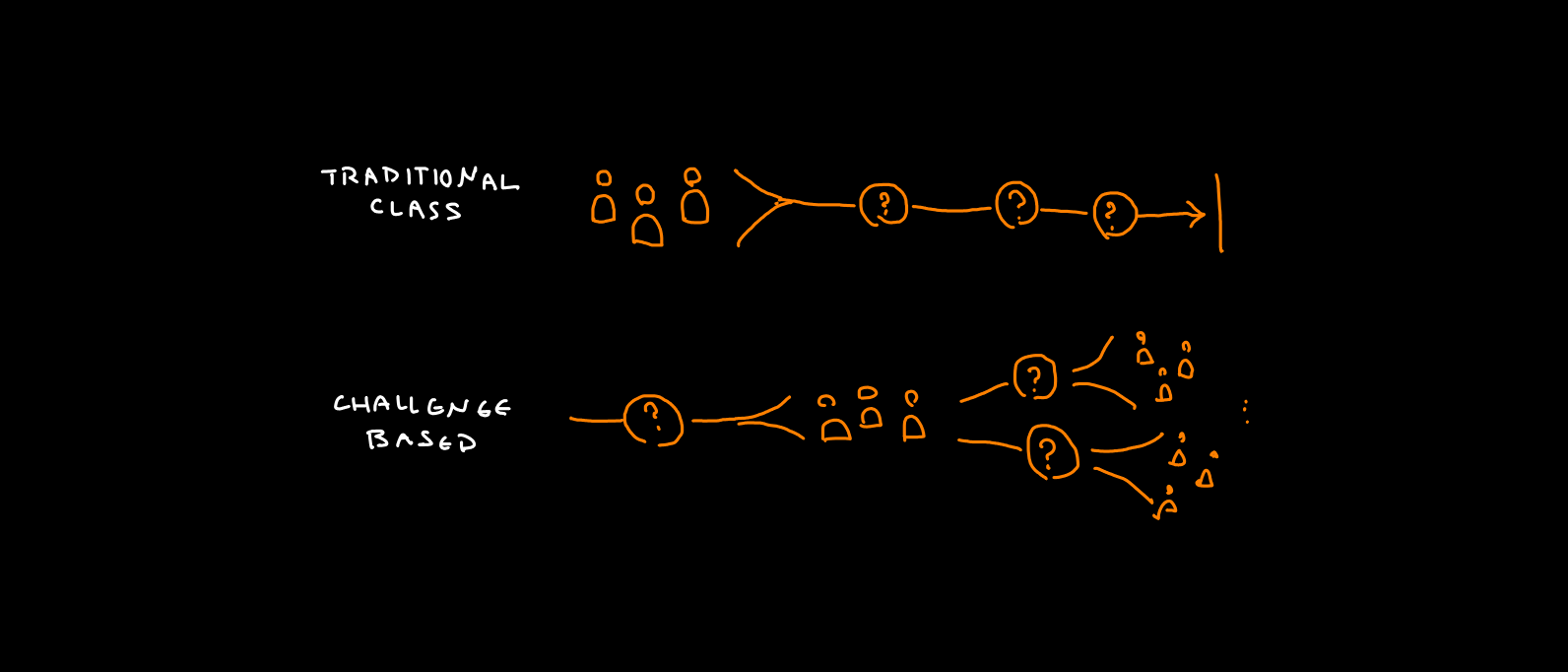
So, the traditional model of education starts by forming a group (a class) and then posing challenges to the students (assignments)
The new model that I want to experiment with flips this around by first posing challenges, which then leads to group formation!
Since the term “flipped classroom” is taken already, maybe I’ll call this “flopped classroom” instead…
#6: Lenses on divergence
I’m not entirely happy with the convergent / divergent dichotomy set forth in idea #3. Those terms don’t seem to capture the essence I was trying to convey. For one, outward attention or “divergent” spaces can often create a mingling effect where it is easier for people to move around and bump into new people.
The chemistry metaphor comes to mind here, what I called “convergent spaces” are much more rigid, like a solid, while “divergent spaces” might involve more movement or bonding with new people, it is more fluid or gaseous than the rigid classroom. We create bonds with each other by having something to share, except where atoms share electrons, people share contexts.
Another metaphor I like is the shift from inward to outward, though there is less clear meaning here on why this should be significant.
I might also wonder about the information flow in a divergent environment. In convergent spaces, a teacher might lecture a class of students in which case the same information is flowing to all the students simultaneously. Whereas in the divergent space, each person might latch on to different sources of information. As well, it may become more of a two-way conversation with the information, or with your peers.
I was reading recently about the acquiring vs. participation metaphors in learning. Where acquiring focuses on individually possessing certain knowledge and concepts, wheras participating highlights being part of a larger whole. I see an analogy here to convergence vs. divergence, a convergence-based classroom is built upon the aquisition metaphor, whereas the divergence-based classroom is built upon the participation metaphor.
#5: Rules and creativity
Games cannot exist without rules. All the depth and strategy of chess come not from the board and pieces but the rules and how they interact which bring the pieces to life. Some may call these constitutive rules, or rules with creative function. These kinds of rules inspire creativity, they make way for strategy, creation, exploration. Rules are like a trellis of the imagination.
Language is bound by rules. The French group Oulipo took
this to the extreme by setting further constraints and rules upon
themselves. Writing without the letter “e” for example (a lipogram), or
replacing nouns with those 7 entries down in the dictionary (N+7). These
creative constraints, while limiting in some aspects, can also serve to
free one’s creativity, to encourage you to experiment or think from new
perspectivesif I were to write about “education” or “learning”
without using the letter “e”, I might use the phrase “ways of knowing”
for example, perhaps this might reframe the idea of education in an
interesting way, not as encumbered by traditional meanings and
associations?
.
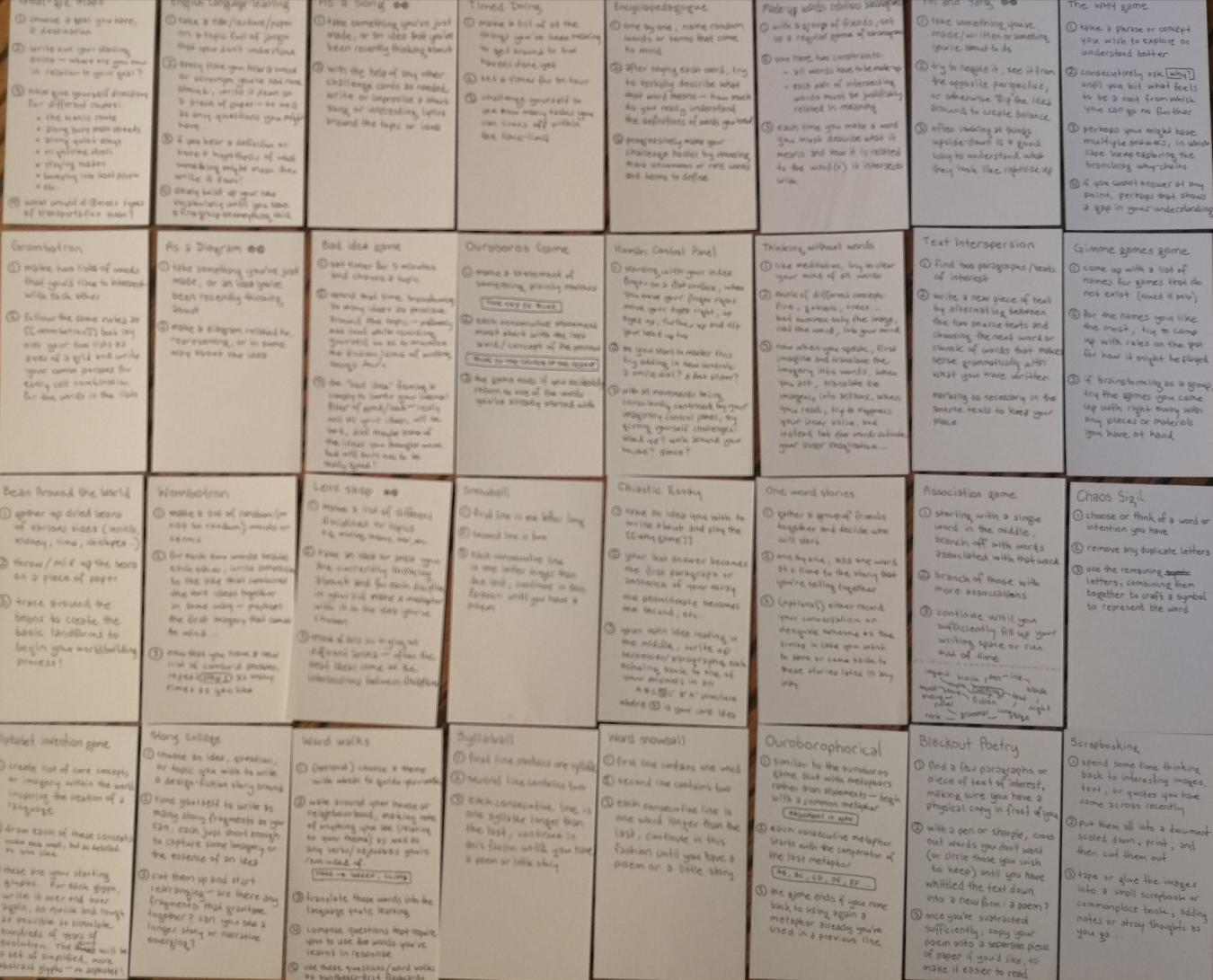
I’ve been compiling some of my own rules, constraints and challenges (see #1), writing them up with the constraint that each must be able to be written in 2-4 steps on a business-card sized piece of paper. These “recipes for creativity” as I like to call them have proven to be useful in the creative process, not just for ideating but also throughout the process of refining and artifacting ideas.
I write in #4 that “role-play is a set of rules that structure social interation” — rules have the possiblity to create entirely new kinds of social experiences, new forms of gathering, new architectures of relating to one another, and that I think is an exciting possibility.
#4: Role-playing
I mentioned in #3 that divergent spaces shift social energy away from ourselves and towards our environment, which creates a more social space by lowering the barrier of interacting with each other. Role-playing takes it a step further. Acting as someone who is not yourself gives you permission to do, say, or interact in ways you wouldn’t normally have done. Something which frees us from the normal constraints and restrictions we put upon ourselves.
From the recent resurgence of Dungeons & Dragons, to eastern
european urban
games, LARPing, and
剧本杀
— a kind of scenario-based murder mystery gamesort of a cross between tabletop role-playing, LARPing,
and escape rooms if I understand correctly
that has taken hold in the Chinese social scene — the
appeal of role-playing seems to be coming to a greater and greater
audience.
What role could it play in education and learning? I’m not sure yet.
In essence, role-play is a set of rulesconstitutive rules
that structure social interaction. I see this as a
possibility for entirely new social experiences, many of which may not
have even been imagined yet. Can role-playing enable new kinds of
collective sense-making? can you imagine a research lab running
idea-improv games?
I imagine even something as simple as everyone putting on a funny hat before entering a classroom could impact the learning experience in a positive way and perhaps lead to some impromptu role-play.
#3: Convergent vs. divergent focus
Our attention in a classroom is typically convergent, directed
towards the single point that is the teacher. Our classrooms are
arranged in such a way to catalyze this, whether tables all facing the
same direction, arranged in a circle, or grouped to form little islands
of convergent focusallowing attention to converge on either the teacher or
the small group of students you’re sitting with at the time
. However there is another, very different way of
arranging space.
It occurred to me at the climbing gym, where my friends and I would often go. It is a space far removed from a classroom context, yet a brilliant learning environment (see: Bouldering in the Classroom). People often stand or sit, alone or in groups, facing the walls, thinking, and then approaching the wall to attempt one of the bouldering routes. It is a space where all skill-levels gather; I can watch a heavily muscled man breeze through a route that challenged me, or a young girl nimbly jump between holds so small and far between I could never dream of attempting the same feat. We all learn from each other, some might approach a challenge in new or unexpected ways, in others we might observe their technique and center of balance which may help us refine our own form.
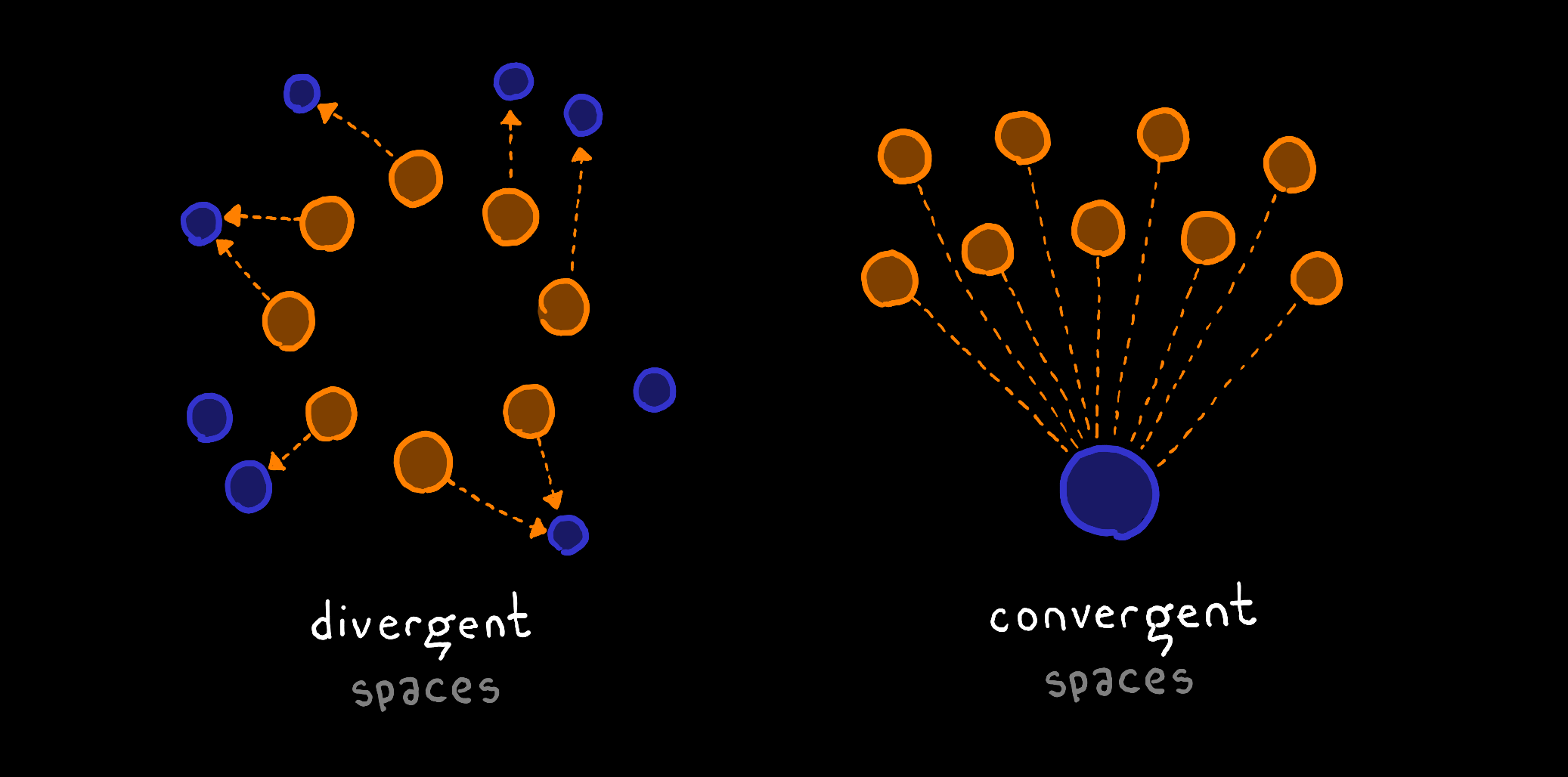
What other spaces are designed around divergent focus? library shelves, museums, certain types of art crits, some aspects of the old monitorial school system…
What I find fascinating about divergent spaces is that they enable
individuals, or small groups, to be learning, exploring, or solving
problems independently. Yet as with bouldering, solving problems
independently can serve to bring people together communally, or to bump
into new people working on the same problem. Divergent spaces are
inherently social spacesmuseums, alas, are not well-suited as social
spaces—however, I would credit that more to social norms and the sterile
white environments that art tends to be situated in
. They shift our focus not inwards but outwards, sparking
conversations about things in our environment, or working together to
solve problems layed out around us.
#2: Collection
Even if following simple individually, any sufficient collection of things has the potential to inspire curiosity. These quick idea notes are one example but there are many more: libraries, cabinets of curiosities, scrapbooks, are.na collections, the Mundaneum…
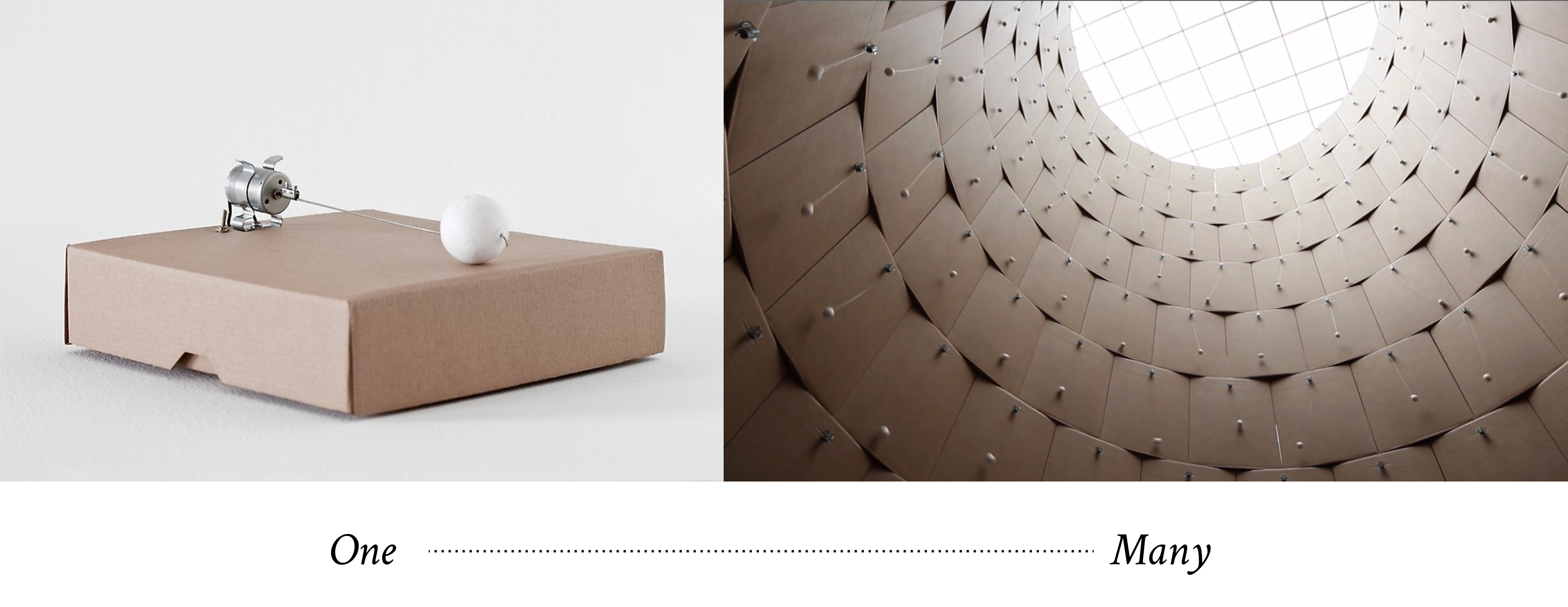
This image captures the concept quite well I feel: a single DC motor
attached by a wire to a cotton ball is not particularly impressive
alone, perhaps it will thump weakly against the box as it spins—but a
collection of over 100 of themEach different exhibition of this work has a different
number of boxes with DC motors and cotton balls: 269, 186, 370,
658…
, now that is quite a bit more meaningful. And
the sound they make in their blissful discordance, like a great stampede
heading infinitely onwards.
Why is collection important to the future of learning?
- Collecting is connected to curating, arranging, coaxing patterns to emerge from chaos
- Collections can be magnets attracting together like objects, images, or ideas
- Collections can be wells of inspiration
- Collecting can be a form of sense-making: quick-idea journals, commonplace books, etc.
- It gives us both a grounded and a birds-eye perspective as we get to see each individual item but also grow to understand the collection as a whole
- …
I must not go on (though this list is becoming a bit of a collection itself) for I must endeavour to keep each idea quick and short, though I daresay I will likely be stumbling across the motif of collections as I continue through my journey of learning futures.
#1: Challenges
This quick-thoughts journal is a spiritual successor to my original Micro Learning Futures challenge to myself back in November of 2019. The goal was to come up with at least one design concept each day of november focused around the future of learning.
Despite only making it halfway through the first micro learning futures challenge, I have constantly found challenges to be a powerful tool for creativity and creation. Over the years I have participated in dozens of game jams, hackathons, and other kinds of challenges and competitions. I have been inspired by inktober and nanowrimo to dabble further with drawing and writing simply because they set out both a compelling challenge and community.
#0: Inspiration
You never change things by fighting the existing reality. To change something, build a new model that makes the existing model obsolete
―Buckminster Fuller